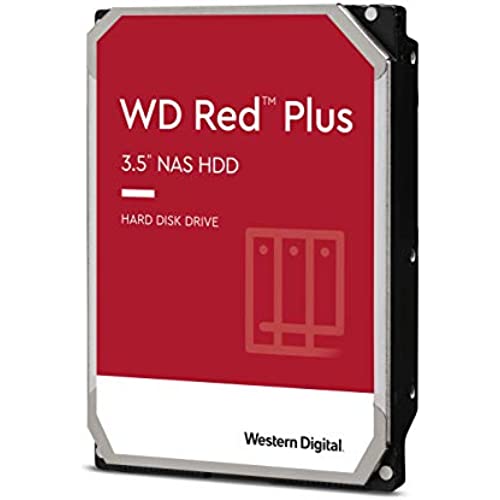
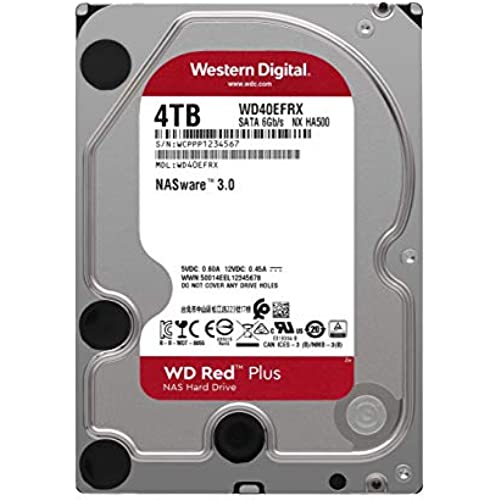
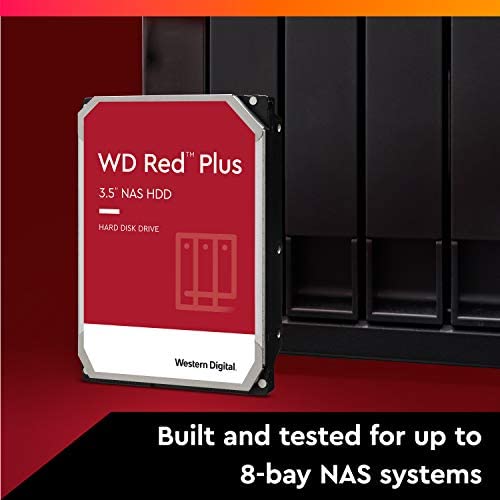
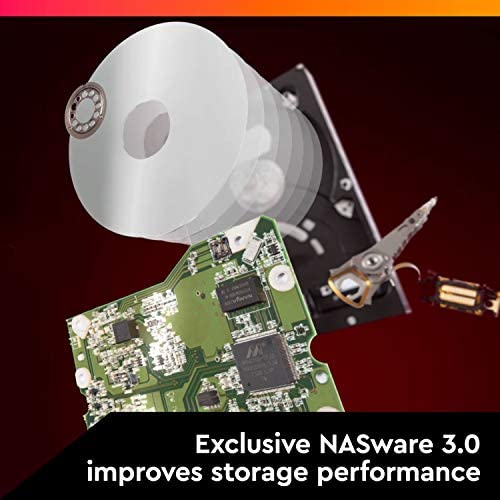

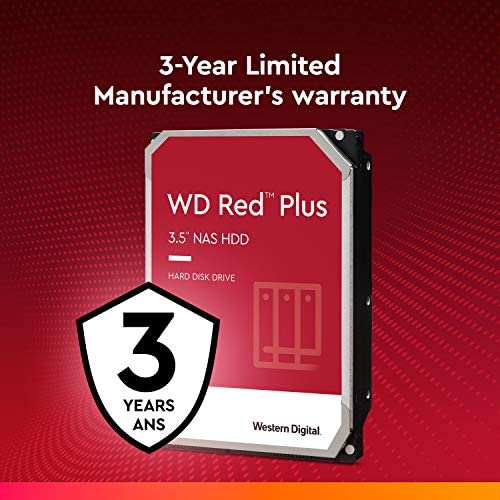
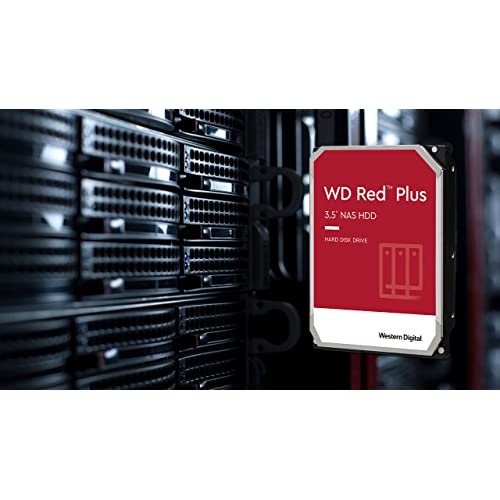







Western Digital 4TB WD Red Plus NAS Internal Hard Drive HDD - 5400 RPM, SATA 6 Gb/s, CMR, 64 MB Cache, 3.5 - WD40EFRX
-

Isaac
Greater than one weekOur famaly TiVo kept getting filled quickly with all the holiday recording and other shows that everyone wanted to record. Was looking at upgrading the TiVo Roamio but the new TiVo software is not exactly great. Instead we opting in upgrading the hard drive. Process was simple and just needed torx screw driver. Removed original 500GB and replaced with 3TB. Once installed TiVo did it’s full set-up and had to configured again. If you have FiOS you will need to have the cablecard reloaded with host, prod, and card ID. Just do a chat and they can do it in about 5 minutes. Update: 12/5/19 So far it has worked with no issues and have so much recordings and only %22 full. Overall very happy with the purchase. On advise is when opening make sure to use a air duster to clean up the fan and inside of TiVo unit. It will extend the life as well ensure it runs cool. Update: 2/17/2021 The hard drive still going strong with no issues. It’s about nearly 75% full based on all the recording series set on TiVo. My 2nd TiVo with original 500GB died this week so will be replacing with 2TB. Overall very happy with purchase.
-

Scott H.
> 3 dayI have it installed in a server tower, with a mix of other drives to include WD Green drives. The Red drive performs as well as any other drive and the drive temperature is lower than surrounding drives, which was one reason I purchased this drive. So far, so good. As I slowly upgrade or replace my current drives with Red drives I will try and come back and report again. UPDATED: 7 JAN 2013 Failed! WHS said it was missing, I took out the drive. Re-installed, tried another cable/power connector, took it out and plugged it into a win 7 box, files came up for a moment then dropped. Drive is sort of seen in drive manager but states that it is not ready. Ran Spinrite 6.0, couldnt see it. Downloaded WD Data Lifeguard Diagnostic for Windows, it stated that it failed due too to many bad sectors detected. I have been a long, long time shopper of WD drives and their media boxes. I was very surprised that it failed and so soon too, since these Red drives are supposed to be tougher, longer lasting, quieter, and cooler than the 5 green drives I have had for years. Not so sure about that... So I will be trying to recover any data I can for a bit but more than likely it is gone, had about half the drive duped using Stablebit but not sure which files...I guess I will find out soon. I am not saying stay away from WD, this is the first drive that I have had fail as far back as I can remember. Even so, every company makes mistakes, I will give them the benefit of the doubt but we will see how customer support works out. UPDATED: 3 August 2013 Okay, I lost a heck of a lot of files. I replaced the failed drive mentioned above about a week later and it has been running for 8 months now, cooler and quieter. I switched to Flexraid using cruise control in snapshot mode. No drive failures yet, I did test Flexraid by pulling out a drive and nothing happened! That is what I want, files keep getting served.... I am going to update my rating. UPDATED: 24 June 2017 Drive still working. Have since bought several more WD Red 4TB drives. I have to buy 3 more over the rest of this year. Only drives I trust and the RMS process on that one drive was super easy. Looking forward to 8 TB Red drives next year!!
-

Barry F. Hunt
> 3 dayI replace my NAS drives every couple of years or so as it gets full, doubling the capacity each time. Prior to these 8TB drives I had a pair of 4TB WD reds, and before that a pair of 2TB WD greens and before that a pair of 1TB WD greens. These drives perform very well - on a par with the 4s I removed. But they make lots of strange noises, like intermittent soft buzzing, and occasional faint humming. They are noticeably noisier than the 4TB reds I replaced. But Ive been running them for almost 2 months without a hiccup. I have yet to lose a WD drive in this NAS over 7 years of 24x7 operation so I will stick with WD until that changes.
-

Shane A. White
12-06-2025I bought these after reading they were for NAS use. I have a QNAP 8 bay NAS. I bought them to replace WD green 2TB drives (which I had suffered regular failures with when used in hardware RAID on my Gigabyte motherboard hardware RAID 5 setup). I read that desktop drives do not have TLER (Time Limited Error Recovery) - which can cause the drives to be dropped from your array when errors are encountered if the drive tries to recover for more than ~12 seconds. These RED drives have TLER built in and will limit recovery time to ~7 seconds or so so the drives are not dropped by the RAID controller. I might not have bought them had I read the NewEgg reviews first, as the reviews are horrible, but Amazon Prime had a great price on these, so I never even considered NewEgg and therefore did not read the reviews. So...with cautious apprehension, I installed two of these in the last 48 hours, allowing each to rebuild on the array. They were packed safely in OEM type cardboard boxes with plastic inserts and then placed into a larger Amazon box with packing material, so they were not beat up. Neither was DOA, and both installed and re-populated with no issues. Only time will tell what the reliability of these is going to be long term, but so far...so good. I am also going to buy a pair of Seagate 3TB NAS drives, and Ill be doing a little reliability shootout to see which lasts longer. With 8 bays total, something is bound to fail at some point, but Im only running four drives for now. Ill report back if and when one fails.
-

WBY
> 3 dayEarlier this year, I took a chance purchasing Seagates new 3TB HD for media storage and it died 2 months later. Since then Ive purchased a 3TB Western Digital RED drive (I would have picked the WD BLACK, but the price difference was a deal breaker). Its not in a NAS (just in PC), and with only one month in service I can say that at this point Im pleased with the drive and its performance. Its not as noisy, and certainly runs cooler than the dead Seagate, but time will tell. UPDATE: 10-14-12 I didnt wait for the six month period to bump it to 5-star status. I didnt mention it before but the dead Seagate was in a USB external housing which is what I put this in. I almost never hear it, and while I havent been as scientific as some (holding a stop watch, etc.)I have moved many large files to/from it, and then to two other external drives (same file each time) and the RED is by far the fastest, making things less time consuming. The others leave me toe-tapping or playing solitare until the transfers are complete. I bought a 2TB, not too long ago and plan to get 2 more 3TB drives before the end of the year. Yes, the RED series has a 3-year limited warranty. UPDATE: 11-17-12 The 3TB RED and my 3, 2TB REDs are still very happy campers, on a 24/7 basis. I recently built a PC for a customer and put the 1TB RED in it (about 3 weeks ago) and they are very happy with the build, and the first comment I received was Its so quiet. Our distributor tried to sway us from using these in anything other than a NAS, remarking that they were too slow, so I did some digging around various tech sites and came up with additional info: Due to its variable speed, Western Digital upped the MTBF from 650,000 hours to 1,000,000 3 year warranty with dedicated 24/7 support WD doesnt state the actual spin-speed, merely saying its Intellipower (meaning less than 7,200rpm), and from what Ive seen most put it in the 5400 to 5900 RPM range. The Drives cache memory was upgraded from DDR to DDR2 In a test pitting RED against other brand hard drives which run at 7200 RPM, it came out in the middle of the pack on random data tranfers, however, when transferring large media files (in the 20+ GB range) the RED beat the Seagate Barracuda by 2 minutes. UPDATE 12/31/12 No problems, runs cool, streams media great. The same goes for the 2- 2TB RED label drives in use. UPDATE 02/26/13 8 months of 24/7 and still going strong (3TB), 6 months of 24/7 and still going strong (2TB). So far, everyone Ive recommended these drives to (and bought them) are also Happy Campers. Update 06/28/2013 Nothing Good, Bad, or Ugly to add to my review. The system is up 24/7 in non-desirable conditions (76-80 degrees F, usually at 60%+humidity) and quality and reliability hasnt changed a bit! I cant recall but it has to be at least a year Ive been using the RED label.
-

Trenton Bennett
> 3 dayThe short summary: these work great for bulk file storage in the home--built to be continually powered up and to store large amounts of data for the home user, power user, or small business. Ive got a love-hate relationship with WD: their USB drives have been problematic and disappointing, but the Caviar Black internal drives have run very well for RAID 0 / RAID 5 gaming in my desktop PCs. I bought these Red volumes to fill in the slots in a home server that had a RAID 1 array where a member had died...it turned out to be cheaper to buy three 4TB volumes, start over, and gain a ton more space than to try to dig up an exact match for the bad drive and still keep a smaller array. This time around, I used Windows Storage Spaces, a feature in Windows 8 and above. On Windows 10 64-bit I was able to set up a large storage space with Parity and use it for my system backups. Western Digital have done a good job making it easier to understand all these drives, and if you stop by their site, youll see what the color codes mean (like Green for everyday desktop, Purple for surveillance systems). If youre big on the details with hard drives, you know that the way theyre built makes some better for gaming, some for large files, some for continuous writes, etc. The Red series is for storage: the kind you stick in a file server and expect them to be running 24/7 or for long periods of time, and youre not needing super-fast response time. Theyve been running continuously since I installed them and a periodic temperature check doesnt seem to indicate theyre overheating and getting stressed. So far Ive been happy with the ease of use of the WD Red 4TB NAS desktop hard drives. They were fairly cheap, they do the job, and I suspect theyll last me for quite a while in my home server.
-

Schmidt
> 3 dayUsually love WD, disappointed it died a few days after Amazons 30 day warranty and they wont even consider it. We are talking 3 days... Will try to get a replacement through WD but there are already warnings on WDs site that they are behind in replacing drives..... Update: 5/18 - WARNING WARNING WARNING.... Western Digital is claiming these are OEM drives (even though it isnt listed anywhere in their description) and WILL NOT HONOR A WARRANTY. Buy at your own risk because they will not replace it!!!!!!!! Very disappointed in Western Digital and these dirty tactics and Very disappoint in AMAZON for allowing the Bait & Switch- False Advertising!!!!!!!!!!!!!!!! Update 5/19 - Western Digital says my drive is OEM and made in 2014. So they are selling 9 year old drives as new and not OEM. Amazon allows them to continue this fraud. Amazon wont stand behind the product that failed 32 days in. Western Digital wont replace it because of the OEM. And the Seller claims they cant replace it because Amazon has all their stock. DO NOT BUY THIS!!!! SCAM
-

Michael S
> 3 daySo far this drive has performed exactly as Id hoped. Some notes: (1) WD Red drives have a 3 year warranty while the WD Green drives have a 2 year warranty. For the extra 10-20 dollars for the 4TB version (when I bought this), the extra year is totally worth it. Friendly tip: All businesses like set their warranties periods such that somewhere between 95-99% of all products sold wont need to be repaired/replaced. If WD is confident that they can give the Red an extra year over the Green, Ill pay the slight bit extra. (2) As with any HDD, I highly suggest that all users run a full disk check the minute they get the device out of the box. Ive been lucky not to have drives show up with any issues. However, the horror stories (Ive heard from friends and read here and on other sites) just make me overly cautious about the shipping and handling of such a delicate piece of hardware. If the full disk check (approx. 8-10 hours for 4TB) doesnt come back with any errors, contact the seller immediately. Again, I was lucky that mine didnt have any issues but I have had friends that found significant failures and had to deal with sending the device back. Better to know about it up front than find out 2 months down the line when the remorse period with the seller has past and your data may take weeks or months to recover if at all.
-

V. Broccoli
> 3 dayThese work well in my QNAP TS-451 NAS setup. Have two 3TB drives in raid 1. Quiet and cool, no problems whatsoever yet. I did notice that even though I have recent firmware on the drives, the load cycle count was still going up: Even though my drives came set to 300 seconds, here were my stats for each drive after 3 months: ~6000 LCC over 1451 hours ~= a load cycle every 900 seconds These drives are supposed to be rated for 300,000 LCC, so 300,000/6000 * 1451 hours = 8 years 8 years aint too bad, (Id probably replace the drives in that time) but it really doesnt provide much buffer. I reasoned that I am still happily using a 1TB drive from 2009 (6 years ago) and expect to for another couple years. So in the end I decided to just disable it for now. Since I didnt have a external SATA enclosure compatible with drives of terabyte size, I had to find a wdidle binary compiled for my NAS. Once I did, disabling the load cycle feature was easy: ------------------------ Move the program to the NAS and make it executable: macbook_computer$ scp idle3ctl [email protected]:/root xxx@xxxxs password: idle3ctl 100% 14KB 14.2KB/s 00:00 [~] # chmod +x idle3ctl [~] # ./idle3ctl -V idle3ctl v0.9.1 ---------- Find your drives locations: [~] # fdisk -l /dev/sd? Disk /dev/sda: 3000.5 GB, 3000592982016 bytes 255 heads, 63 sectors/track, 364801 cylinders Units = cylinders of 16065 * 512 = 8225280 bytes Device Boot Start End Blocks Id System /dev/sda1 1 267350 2147483647+ ee EFI GPT Disk /dev/sdb: 3000.5 GB, 3000592982016 bytes 255 heads, 63 sectors/track, 364801 cylinders Units = cylinders of 16065 * 512 = 8225280 bytes Device Boot Start End Blocks Id System /dev/sdb1 1 267350 2147483647+ ee EFI GPT ... ------ Check the current values: [~] # ./idle3ctl -g105 /dev/sda [~] # ./idle3ctl -g105 /dev/sdb (both said 300 seconds) ------- disable both (can do just one to test first): [~] # ./idle3ctl -d /dev/sda [~] # ./idle3ctl -d /dev/sda -------- reboot (I rebooted from the web UI) and check again: [~] # ./idle3ctl -g105 /dev/sda Idle3 timer is disabled [~] # ./idle3ctl -g105 /dev/sdb Idle3 timer is disabled -------- In the end I wouldnt let the LCC feature sway you one way or the other. Its been fixed to an acceptable timer setting now, and in many cases is probably useful. I just disabled it to be safe so I can get hopefully 8+ years out of these drives.
-

The Taylors
> 3 dayI bought these to run in a RAID Array after my WD Blue RAID array kept failing. The RED drives, with their TLER support, prevent arrays from breaking due to read/write delays unlike the blue drive,s which was the issue I was having. Also, with their 3D Active Balance Plus you can run them in multi drive environments (or even in a PC with other fans running) without fear of increased wear/tear or damage. At first I had thought all the technology was just gimmick, but when my Blue array kept failing, I upgraded to these and havent had a single issue since. They are not the fastest drives available, but then again most people with NAS dont have enclosures fast enough to take advantage of the increased speed regardless... I use my HP Z600 as my NAS, which allows me to use the data/drives without a network bottleneck locally, and allows my other computers to access it through the LAN. It works well for what Im using it for. Overall, I can say Id buy them again. They have been running 24/7 for 7 months now without any issues, so so far, so good. Ill update this review if anything changes.

